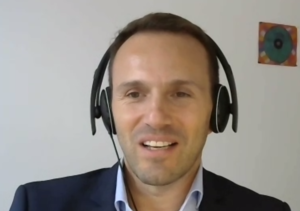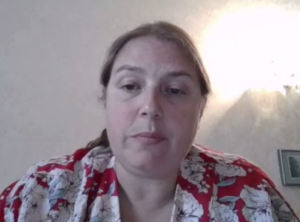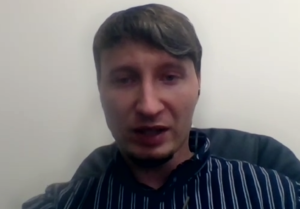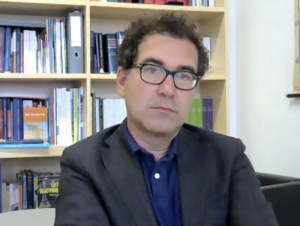On September 29, 2021, during a roundtable on “Market Concentration in the Burshtyn Electricity Trading Zone,” experts from the USAID Energy Security Project (ESP) and the Energy Community Secretariat presented an analysis and recommendations on market concentration in the wholesale electricity market and how to facilitate its liquidity. The analysis and recommendations were prepared at the request of the National Energy and Utilities Regulatory Commission (NEURC). After the presentation, a lively discussion took place on developing mechanisms and approaches to address concentration in the wholesale electricity market and facilitate improved liquidity, as well as possible ways to ensure competition and promote market development.
More than 80 participants attended the event, including representatives of the Energy Community Secretariat, the Verkhovna Rada of Ukraine, the Ministry of Energy, the Anti-Monopoly Committee of Ukraine, the NEURC, NEC Ukrenergo, SE Market Operator, the National Securities and Stock Market Commission (NSSMC), USAID/Ukraine, and the European Commission’s Support Group for Ukraine.

Analyzing the Ukrainian wholesale electricity market, electricity expert Arben Kllokoqi of the Energy Community Secretariat noted: “There is no single solution on how to make the market liquid and competitive. But market participants should strive to take risks, to create portfolios whereby they will be able to manage in different time frames, and what is really important is transparency.” Kllokoqi emphasized Ukraine’s significant progress in achieving transparency in the electricity market and expressed confidence that implementating REMIT’s provisions in Ukrainian legislation will contribute to market development. He also noted that if market participants effectively used the Ukrainian electricity market’s large cross-border capacity, it would enhance competition and liquidity in the market. “It is necessary to ensure market synchronization to use the cross-border capacities as much as possible. Perhaps these are obvious things. But if so, why is there still no synchronized market mechanism?” the Energy Community Secretariat expert asked rhetorically.

Ashley King, USAID Ukraine Energy Officer, added that although all segments of the electricity market are currently operating, including the ancillary services market, not everything goes smoothly and attention must be paid to liquidity.

Yevhenii Zaretskyi, USAID ESP Electricity Market Expert, informed roundtable participants that the market analysis in the Burshtyn Electricity Trading Zone (also known as the Burshtyn Energy Island, or BEI) was conducted according to three indices: the Herfindahl-Hirschman Index, the Residual Supply Index, and the Pivotal Supplier Index. “All three indices demonstrate a material relationship between available imports and market power: if there are no imports, then competition is very limited,” he added. According to Mr. Zaretskyi, USAID ESP recommendations could be split into short-term actions, which do not require considerable changes to legislation, and long-term recommendations, which are more efficient. The short-term recommendations include introducing a differentiated approach to determining price caps in the BEI. Among the long-term recommendations are several proposals based on positive experience in the EU and/or U.S. markets: regulated access to electricity, direct trade commitments, virtual power plant auctions, and specific market maker commitments. In particular, it is extremely important for the regulator to constantly monitor price jumps in the BEI in order to detect abuses and take appropriate regulatory measures. Mr. Zaretskyi stressed the role of joint auctions (which have not yet been introduced in Ukraine) in developing cross-border trade and the importance of transforming the bilateral contract market into a competitive forward market with standardized contracts and mandatory physical delivery.

Dr. Fatih Kolmek, Senior Electricity and Renewables Sectors Manager, added that joint auctions would considerably change the market situation and facilitate cross-border trade. “Implementation of the rules for joint auctions is what is currently lacking and what Ukraine needs to work on now,” he emphasized. In addition, Dr. Kolmek stressed that the results of the USAID ESP analysis will help resolve the problem of market concentration, not only for the BEI, but also for the trading zone of Ukraine’s integrated energy system (IES). “The main conclusion is that an approach should be comprehensive and developed for the entire energy system of Ukraine,” he summarized, acknowledging that more efforts are needed within the IES and that they will be more complex.

Dirk Bushle, Deputy Director of the Energy Community Secretariat, drew attention to the fact that resolving the liquidity problem in the BEI involves not only regulatory but also competitive aspects. In addition, he focused on the environmental aspect of the problem, as emissions of environmentally harmful substances from facilities in the BEI “are approaching the threshold values.”
Summing up the discussion, USAID ESP Chief of Party Dean White emphasized the pressing relevance and timeliness of the topic raised at the roundtable and assured the participants that USAID ESP is ready to share analytical materials: “Ukraine is on the path to reforms and has the opportunity to implement them.”
For her part, NEURC Commissioner Olga Babiy expressed her gratitude to USAID ESP for holding the roundtable and presentation of the analysis, noting that USAID ESP expertise is important for the regulator and is always taken into account. “Energy markets, which were launched two years ago, show a certain trend, both in the energy system in general and in the BEI in particular. We see fairly high liquidity in various market segments and fairly high concentration in various segments, and this might affect the pricing in these segments. To enable us as the regulator to make informed decisions on various regulatory actions, your opinion and your analysis are important,” added Babiy.
